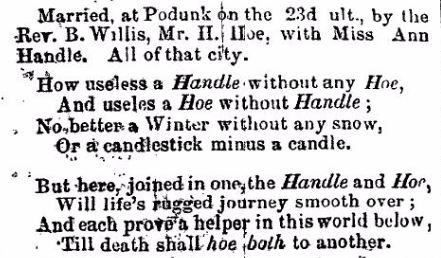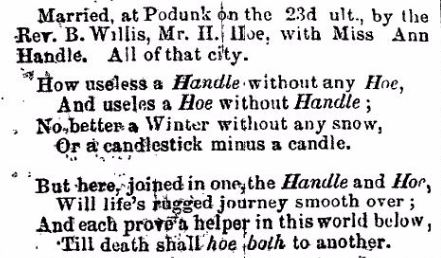By John Wertis
Etymologists tell us that Podunk is a term of mild derision that has been used to refer to a small, insignificant settlement.
There are references from the 1600s to an indigenous term resembling “Podunk” from Connecticut, Massachusetts, and Long Island. The term appears to have been used by speakers of the Mohegan-Pequot language shared by various Indian nations living in Southern New England and eastern Long Island and is thought to mean “a boggy place.”[1]
Its earliest documented colonial use dates to 1636, when various property deeds and other documents mention the Podunk Indians and a meadow and stream in Connecticut that share the name.[2] In a letter written in 1666, Connecticut governor John Winthrop Jr. (1606-1676) noted that “yesterday there was a party of . . . Mohaukes at Podunk (a place between this town [Hartford] & Windsor) who were discovered by the Indians, & as sone [sic] as discovered they fled.”[3]

In Ulysses the name Podunk has long been applied to a region surrounding the junction of Bolter Creek with Taughannock Creek. This area lies at the southern terminus of Trumansburg’s South Street, one of the earliest roads opened by the Town of Ulysses. This directionally named street ran from Abner Treman’s (1761-1823) cabin on the Ithaca-to-Geneva Turnpike, due south, to a mill site operated by David Atwater in 1804.

The first known reference that names this area in writing appears in the Town of Ulysses “Record of Commissioners of Highways, 1846-1898” as part of the description of another road described “running as per record of servay [sic] entered in the Town Book April 21, 1866 ending at the Podunck Road.” (Today’s Podunk Road (CR 146) runs between Trumansburg’s South Street Extension and Mecklenburg Road/NYS 79 in Enfield.) While Stone and Stewart’s New Topographical Atlas of Tompkins County of 1866 clearly shows a cluster of residences and businesses at the location, no identifying name is given.
In the decades after the Civil War and into the early 1900s, Podunk reached the high point of its commercial development. The creeks powered a lumber mill, a carriage factory, and a manufacturing plant that produced barrels and other wooden items.[4]
In this period, Podunk attained local notoriety for two crimes. The Trumansburg Sentinel of January 15, 1890, ran an extensive piece about the hamlet. Relying on their files, they rehashed the murder of Ann Cox Mason that occurred there in 1888 and the thrashing given the wife beater, Mr. Evarts, by the hooded “White Caps” who may or may not have been members of a local KKK.
This article was followed by a second one published on January 25, 1890, submitted by “A Podunker” who stated: “History to be history, should be correct.” This article then details all the current residents and their occupations. Orin Clark (1817-1898) is referred to as the presumptive mayor of Podunk of that day.

When the radio-journalist, Lowell Thomas (1892-1981), alleged in a national radio broadcast that there was no such place as “Podunk” in the spring of 1939, the then long-time resident and self-appointed mayor, Milt Cuffman (1863-1946), felt moved to respond to set the record straight in a column in the Trumansburg leader.
First, admitting that at that time only “eight homes make up the ‘town’ proper,” he described the Podunk of his youth and recounts the disappearance of the several mills, retail businesses, and the district’s one-room schoolhouse. In conclusion, he took the opportunity to give his personal explanation for the name, Podunk, derived from the sound made by the way “the rushing waters of Bolter Creek descended on a sawmill wheel in the old days. . . . [T]he wheel spoke the name ‘Po-dunk’ as it went ’round and ’round as plainly as if I had said it myself.”

Notably absent from all historical accounts of the hamlet is mention of a Podunk post office. Having a named post office put hamlets on maps and into “official” records as independent entities. Living less than a mile from the center of Trumansburg, hamlet residents have always received their mail through that village’s postal designation.
Perhaps it is best said that our “Podunk” has long been a state of mind, an independent community with a pride of place expressed through the local use of its unofficial name.
John Wertis is the Town of Ulysses Historian.
ENDNOTES
[1] Read, Allen Walker. “An Updating of Research on the Name ‘Podunk,’” in Murray Heller (ed.). Names, Northeast Amerindian Names, Publication II, Northeast Regional Names Institute, Saranac Lake, NY, North Country Community College Press, 1980, pp. 86-99.
[2] Read, p. 87.
[3] Read, Allen Walker, “The Rationale of ‘Podunk’,” American Speech, Vol. 14, No. 2, April 1939, p. 100.
[4] Wren, David. “Ulysses Town Talk: Yes, Virginia there is a Podunk,” The Ithaca Journal, August 2, 2015, https://www.usatoday.com/story/news/local/2015/08/02/ulysses-town-talk/31028633/
